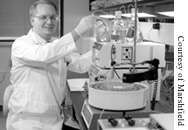A Journey of DNA Samples
In Search of Prostate Cancer Genes
The journey of a constitutional DNA sample, the DNA that makes up an individual’s human genome, most often begins with taking someone”s blood.
The other source for DNA samples used in prostate cancer research is from prostate tumor pieces (specimens) of men with prostate cancer.
1.  Blood is an excellent source of lots of fresh cells so blood samples are a most efficient way of getting lots of DNA.
Blood is an excellent source of lots of fresh cells so blood samples are a most efficient way of getting lots of DNA.
In Dr. Catalona’s genetic studies for prostate cancer, the blood can be from one or more brothers diagnosed with prostate cancer or from someone in the control group who does not have prostate cancer.
 1. These samples are taken from removed prostate glands.
1. These samples are taken from removed prostate glands.
When compared with the constitutional DNA of the same man, this prostate cancer cell DNA can identify the mutations or changes that occur in the actual development of prostate cancer.
 2. Only the white blood cells have nuclei so only they can provide DNA. Through a series of laboratory processes, the red blood cells are removed and the DNA is taken from the white blood cells.
2. Only the white blood cells have nuclei so only they can provide DNA. Through a series of laboratory processes, the red blood cells are removed and the DNA is taken from the white blood cells.
 2. The prostate tissue samples are examined by a pathologist who selects and stains histologic (microscopic) slices which show evidence of prostate cancer cells.
2. The prostate tissue samples are examined by a pathologist who selects and stains histologic (microscopic) slices which show evidence of prostate cancer cells.
 3. In preparation for all the separation processes, blood samples are carefully labeled. The separated and labeled DNA is distributed to scientists.
3. In preparation for all the separation processes, blood samples are carefully labeled. The separated and labeled DNA is distributed to scientists.
In the case of the Dr. Catalona’s collaboration, scientists are in search of constitutional genes involved in the development of prostate cancer.
 3. These selected microscopic tumor samples are sent to pathologists who use a laser capture microscope to remove individual prostate cancer cells.
3. These selected microscopic tumor samples are sent to pathologists who use a laser capture microscope to remove individual prostate cancer cells.
This step is fundamental because prostate cancer very often consists of a mixture of malignant cells and normal cells not malignant.
Molecular biologists must know they are looking at pure prostate cancer cells when they are searching for mutational changes.
 4. Scientists take the DNA and convert it into forms accessible for study.
4. Scientists take the DNA and convert it into forms accessible for study.
Eventually, the procedures involve equipment which convert the physical samples into readable data.
 4. The prostate cancer DNA samples that potentially look good for further study are cloned and propagated in bacteria.
4. The prostate cancer DNA samples that potentially look good for further study are cloned and propagated in bacteria.
 5. Ultimately the form of the DNA studied is a printout of letters and graphs which illustrate the sequences of the genes.
5. Ultimately the form of the DNA studied is a printout of letters and graphs which illustrate the sequences of the genes.
 5. Gels, which allow separation of the DNA samples, are processed and converted onto a readable film similar to an x-ray. The radioactive emissions can reflect deletions in the chromosome of the prostate cancer cell being studied.
5. Gels, which allow separation of the DNA samples, are processed and converted onto a readable film similar to an x-ray. The radioactive emissions can reflect deletions in the chromosome of the prostate cancer cell being studied.
The film results can then be displayed and analyzed on a computer.
 6. At the same time, in another part of the country, other scientists are studying the prostate tumor cell samples and also the constitutional DNA collected from family members diagnosed with prostate cancer.
6. At the same time, in another part of the country, other scientists are studying the prostate tumor cell samples and also the constitutional DNA collected from family members diagnosed with prostate cancer.
They test the candidate genes for expression in normal human prostate cells and then for lack of expression in prostate tumor cells.
Genes that are expressed in normal prostate, but have aberrant expression in tumor tissue are sequenced, using DNA from affected family members, to test for an inherited genetic mutation that predisposes individuals to cancer.
 7. At the completion of most laboratory studies, the responsibility for conclusions is assigned to statisticians.
7. At the completion of most laboratory studies, the responsibility for conclusions is assigned to statisticians.
Whether the study is on constitutional DNA or prostate cancer cell DNA, statisticians enter the sequences into a computer for, in the case of Dr. Catalona’s collaboration, linkage analysis of the DNA of the brothers who have a history of prostate cancer in their families.
If a linkage or connection is found, then that region of the chromosome is targeted for further analysis in future studies.
 8. Both the constitutional DNA and the prostate cancer tumor samples end up in the same place stored in a freezer labeled and available for studies that could take place months or years from now.
8. Both the constitutional DNA and the prostate cancer tumor samples end up in the same place stored in a freezer labeled and available for studies that could take place months or years from now.











